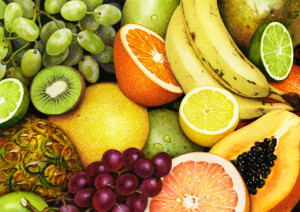Nobody Can Prove That Cold-Pressed Juice Is Better for You
IF YOU’RE THE type of modern citizen with a gym membership and/or a road bike, you’ve probably heard at least a little about cold-press juicing. Celebrities deliver breathless testimonials about their juice’s improved nutritional profile, magically legitimizing $12-a-bottle prices. And startups are popping up to capitalize on the trend—one raising $120 million by promising to deliver pre-packaged fruit, ready to be juiced on its proprietary machine.
The science, at first, sounds pretty good. Good enough, at least, to convince consumers to pay up to $2,500 for the privilege of making the right kind of juice at home with their own blender. See, most juice blenders are centrifugal, with fast-spinning blades that rip apart produce, exposing it to oxygen and heat in the process. Both of those things can degrade vitamins and phytochemicals—the things, nominally, you’re trying to consume. But a cold-press (or “masticating”) juicer crushes and squeezes, sidestepping the nutrient-killing extra oxygen and heat.
Seems legit, right?
But those claims don’t hold water (or juice). The nutrients that go into your juice are not necessarily nutrients that stay there. And they’re not necessarily the nutrients that your body is going to absorb, either.
How you make juice definitely changes the nutrients that show up in the final fluid. Plenty of research shows that cold-pressing’s high-throughput industrial cousin, high-pressure processing, does a good job at preserving more of the micronutrients in produce than the alternative, thermal processing, which raises the juice’s temperature to kill bugs within. But that generalization doesn’t apply to every nutrient. For example, different technologies don’t have much impact on minerals like calcium, iron, and magnesium.
And certain micronutrients have their own weird outcomes, changing the impact of processing on a fruit-by-fruit or vegetable-by-vegetable basis. Take tomatoes, for example. You’ve probably heard that the lycopene in tomatoes is good for you; ketchup manufacturers love to tout its health benefits. But lycopene actually comes in two slightly different structural forms, called isomers. The trans isomer of lycopene shows up in red tomatoes, but your body doesn’t absorb it well. Add heat, though—like maybe from a centrifugal blender—and those trans-lycopenes turn into cis-lycopenes, which your gut is much better at absorbing. “In some cases, the heat is helping convert the metabolites into useful, absorbable compounds,” says Bhimu Patil, director of the Vegetable and Fruit Improvement Center at Texas A&M University. So cold-pressing’s lack of heat isn’t always a good thing.
On top of that uncertainty, everybody’s guts handle nutrients differently. The bacteria that line your intestines chemically transform the nutrients from your food, which can make them more or less absorbable. “I cannot say that what you see in the juices is what you see in the human body,” says Patil. In an ideal world, everyone would get their gut microbiome sequenced like Michael Pollan to help determine which nutrients will be favorably absorbed. But for now, it’s kind of a (ahem) crapshoot.
Finally, the way your gut lining absorbs those nutrients depends significantly on the other compounds that are in there at the time. Consuming fruits and vegetables with fats can significantly improve their uptake, for example. And while one of the big arguments for cold-pressed juices is that they include more of the natural fiber that occurs in fruits and vegetables, that isn’t necessarily awesome. “Fiber might actually sequester some of these compounds,” says Steven Schwartz, a food scientist at Ohio State. In other words, the fiber can prevent certain nutrients from being absorbed.
You’re detecting a bit of weaseling here—in some cases this, in some cases that. But that’s how things are with nutrition research, especially when you’re trying to figure out something as complicated as the metabolism of the hundreds of vitamins and phytochemicals in produce. “It’s expensive to follow all the nutrients through whatever processing you’re looking at,” says Diane Barrett, a fruit and vegetable product specialist at the University of California, Davis. Food scientists often use vitamin C as a stand-in for a laundry list of phytochemicals, because it’s quite susceptible to both heat and oxygen. But really reliable results would require that “every nutrient has to be studied on its own,” says Schwartz. His lab at Ohio State is beginning to do just that, analyzing the broader metabolic profiles of study participants before, during, and after they eat and drink.
Until then, if you love juice, keep drinking it (as long as you’re balancing it out with other foods, obviously). The levels of nutrients in juice certainly change depending on how you make it, but with so much variability—and with so much science left to be done—that it’s impossible to tell on a recipe-by-recipe basis which kind of blending will give you, individually, the best nutrient absorption. And it’s not even clear whether absorbing those nutrients will make you that much healthier; long-term studies of fruit and vegetable intake show the biggest effects on cardiovascular disease reduction, but scientists don’t know if juices would do the same thing. Plus, levels of nutrients and phytochemicals in your juice depend more on the quality of the produce: how it’s grown, when it’s harvested, and how fresh it is. In a big-bag supermarket, the farm-to-produce-aisle cycle can be weeks long.
That’s the important part: Is it worth shelling out hundreds of dollars for a cold-press juicer on the off-chance it’ll improve a few nutrient levels? Nobody knows. So no.
Go Back to Top. Skip To: Start of Article.


